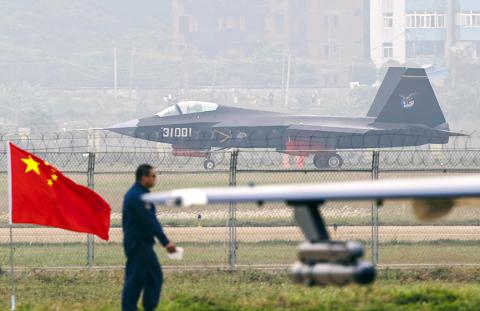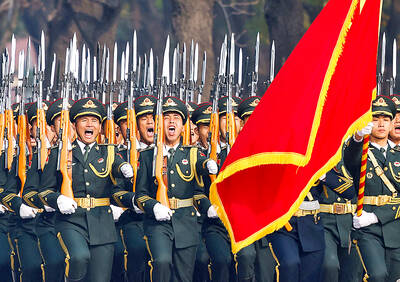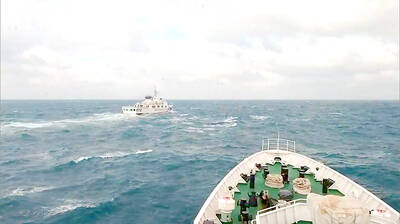China’s massive military modernization program is dominated by preparations for a conflict with Taiwan and the possibility of US intervention, a Pentagon report said on Friday.
The report, which was issued in Washington, said that Beijing is ready to conduct missile attacks and precision strikes against the nation’s air defense systems, air bases, radar sites, missile silos, space assets and communications facilities.
All of this in an attempt to “degrade Taiwan’s defenses, neutralize Taiwan’s leadership or break the public’s will to fight.”

Photo: Reuters
In its annual report to the US Congress on China’s military and security developments over the previous year, the Pentagon said Beijing continues to pursue a long-term, comprehensive military modernization program designed to improve its armed forces capacity to fight short-duration, high-intensity regional conflicts.
“Preparing for potential conflict in the Taiwan Strait remains the focus and primary driver of China’s military investment,” it said.
The report added: “China is increasing its emphasis on preparations for contingencies other than Taiwan, such as contingencies in the East China Sea and South China Sea.”
According to the report, China’s strategy incorporates persuasion and coercion to deter or repress moves toward Taiwanese independence.
Despite a warming in cross-strait relations during the administration of President Ma Ying-jeou (馬英九), “there have been no signs that China’s military posture opposite Taiwan has changed significantly,” it said.
The report said that the People’s Liberation Army (PLA) has developed and deployed military capabilities to coerce Taiwan or to attempt an invasion if necessary.
It said that China appears to be prepared to defer the use of force as long as it believes that unification remains possible in the long term and the costs of conflict outweigh the benefits.
If the decision is made to use force against Taiwan, the report said that China might first signal its readiness and then build up a force “to optimize the speed of engagement over strategic deception.”
Another option would be for China to sacrifice overt, large-scale preparations in favor of surprise to force rapid military and political resolution before other countries could respond, it said, adding that maritime and air blockades are also a possibility.
“China might use a variety of disruptive, punitive or lethal military actions in a limited campaign against Taiwan, likely in conjunction with overt and clandestine economic and political activities,” the report said.
It added: “Such a campaign could include computer network or limited kinetic attacks against Taiwan’s political, military and economic infrastructure to induce fear in Taiwan and degrade the populace’s confidence in the Taiwan leadership.”
“Similarly, PLA special operations forces could infiltrate Taiwan and conduct attacks against infrastructure or leadership targets,” it said.
The report said that the PLA is capable — with few overt preparations — of launching an invasion of small Taiwan-held islands in the South China Sea, such as the Pratas Islands (Dongsha Islands, 東沙群島) or Itu Aba Island (Taiping Island, 太平島).
A PLA invasion of medium-sized, better defended outlying islands such as Matsu or Kinmen is within its capabilities, but would risk galvanizing pro-independence sentiment and generating international opposition.
Large-scale amphibious invasion of Taiwan proper would involve “significant political and military risk” and the report indicates that scenario is unlikely.
Nevertheless, the report says that the PLA Air Force has stationed a large number of advanced aircraft within range of Taiwan, providing them with significant capability to conduct air superiority and ground attack operations.
At the same time, China’s long-range air defense systems provide “a strong layer of defense against a counterattack.”

The Ministry of Foreign Affairs (MOFA) yesterday said it is closely monitoring developments in Venezuela, and would continue to cooperate with democratic allies and work together for regional and global security, stability, and prosperity. The remarks came after the US on Saturday launched a series of airstrikes in Venezuela and kidnapped Venezuelan President Nicolas Maduro, who was later flown to New York along with his wife. The pair face US charges related to drug trafficking and alleged cooperation with gangs designated as terrorist organizations. Maduro has denied the allegations. The ministry said that it is closely monitoring the political and economic situation

Conflict with Taiwan could leave China with “massive economic disruption, catastrophic military losses, significant social unrest, and devastating sanctions,” a US think tank said in a report released on Monday. The German Marshall Fund released a report titled If China Attacks Taiwan: The Consequences for China of “Minor Conflict” and “Major War” Scenarios. The report details the “massive” economic, military, social and international costs to China in the event of a minor conflict or major war with Taiwan, estimating that the Chinese People’s Liberation Army (PLA) could sustain losses of more than half of its active-duty ground forces, including 100,000 troops. Understanding Chinese

UNRELENTING: China attempted cyberattacks on Taiwan’s critical infrastructure 2.63 million times per day last year, up from 1.23 million in 2023, the NSB said China’s cyberarmy has long engaged in cyberattacks against Taiwan’s critical infrastructure, employing diverse and evolving tactics, the National Security Bureau (NSB) said yesterday, adding that cyberattacks on critical energy infrastructure last year increased 10-fold compared with the previous year. The NSB yesterday released a report titled Analysis on China’s Cyber Threats to Taiwan’s Critical Infrastructure in 2025, outlining the number of cyberattacks, major tactics and hacker groups. Taiwan’s national intelligence community identified a large number of cybersecurity incidents last year, the bureau said in a statement. China’s cyberarmy last year launched an average of 2.63 million intrusion attempts per day targeting Taiwan’s critical

‘SLICING METHOD’: In the event of a blockade, the China Coast Guard would intercept Taiwanese ships while its navy would seek to deter foreign intervention China’s military drills around Taiwan this week signaled potential strategies to cut the nation off from energy supplies and foreign military assistance, a US think tank report said. The Chinese People’s Liberation Army (PLA) conducted what it called “Justice Mission 2025” exercises from Monday to Tuesday in five maritime zones and airspace around Taiwan, calling them a warning to “Taiwanese independence” forces. In a report released on Wednesday, the Institute for the Study of War said the exercises effectively simulated blocking shipping routes to major port cities, including Kaohsiung, Keelung and Hualien. Taiwan would be highly vulnerable under such a blockade, because it